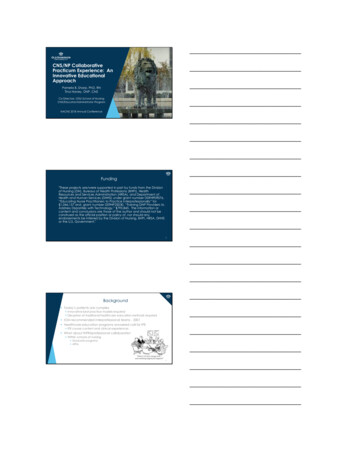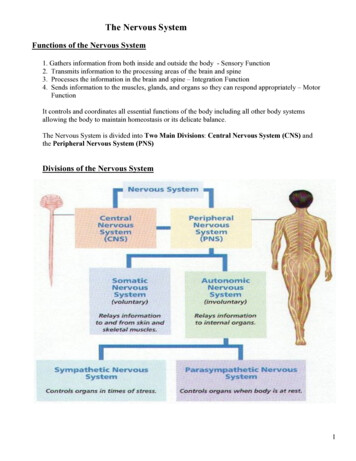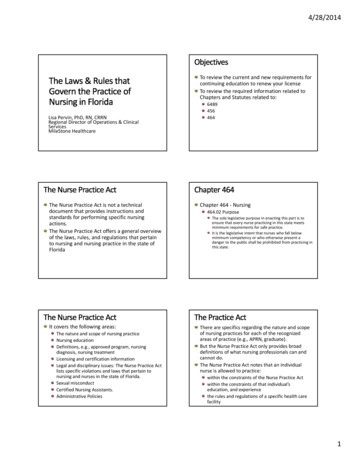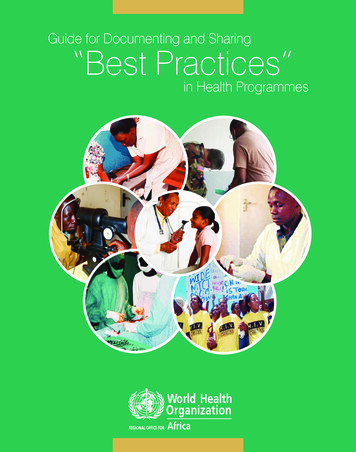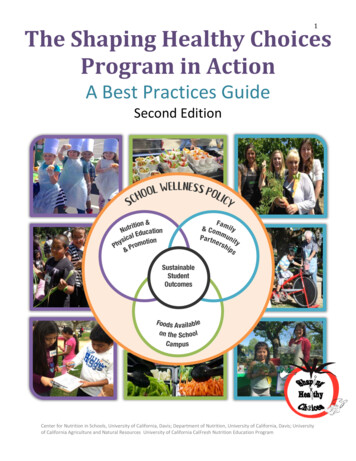
Transcription
1The Shaping Healthy ChoicesProgram in ActionA Best Practices GuideSecond Edition Center for Nutrition in Schools, University of California, Davis; Department of Nutrition, University of California, Davis; Universityof California Agriculture and Natural Resources University of California CalFresh Nutrition Education Program
2Center for Nutrition in Schools, University of California, Davis; Department of Nutrition, University of California, Davis;University of California Agriculture and Natural Resources University of California CalFresh Nutrition Education Program
Table of Contents3Acknowledgements . .5Message from The UC Davis Center for Nutrition in Schools andUC CalFresh Nutrition Education Program . 7IntroductionShaping Healthy Choices Program Spotlight . . .10Shaping Healthy Choices Program Background at a Glance . .13Facilitator Tips: How to Get the Most from thisBest Practices Guide 16Bringing it all TogetherKey Findings to Consider for Future Implementation . 21Nutrition and Physical Education & PromotionImplementing Discovering Healthy Choices Curriculum . 25Building an Instructional Garden . .37Implementing Cooking Up Healthy Choices Curriculum .43Implementing Healthy Choices In Motion Curriculum .49Foods Available on the School CampusEnhancing the School Lunchroom with a Salad Bar, Regional Produce,and Smarter Lunchrooms Movement Principles .59Family & Community PartnershipsDistributing Team Up for Families Newsletters .69Organizing a Community Health Fair 73School Wellness PolicyForming a School Wellness Policy Committee . 79Center for Nutrition in Schools, University of California, Davis; Department of Nutrition, University of California, Davis;University of California Agriculture and Natural Resources University of California CalFresh Nutrition Education Program
4Center for Nutrition in Schools, University of California, Davis; Department of Nutrition, University of California, Davis;University of California Agriculture and Natural Resources University of California CalFresh Nutrition Education Program
5AcknowledgementsAuthorsCenter for Nutrition in SchoolsDepartment of Nutrition, University of California, DavisJacqueline J. Bergman, PhDJessica D. Linnell, PhDRachel E. Scherr, PhDSheri Zidenberg-Cherr, PhDThe UC Davis Center for Nutrition in Schools would also like to thank thefollowing individuals for their contributions to The Shaping HealthyChoices Program in Action: A Best Practices Guide.Kelley M. Brian, MPHUC (University of California)Cooperative Extension,Placer and Nevada CountiesDavid Ginsburg, MPHUC CalFresh NutritionEducation ProgramAnna Martin, MAUC Cooperative Extension,San Joaquin CountyMarilyn Briggs, PhD, RDDepartment of NutritionUniversity of California, DavisPaul Hauder, MSCarroll Elementary SchoolElk Grove Unified SchoolDistrictMary Ann Mills, BSUC CalFresh NutritionEducation ProgramRosemary Carter, BAUC Cooperative Extension,Placer and Nevada CountiesCarol Hillhouse, MSAgricultural SustainabilityInstituteSusan Donohue, MAUC Cooperative Extension,Butte ClusterLorena Hoyos, MEdUC Cooperative Extension,San Joaquin CountyMichelle Drake, BSFood and Nutrition ServicesElk Grove Unified SchoolDistrictShannon Klisch, MPHUC Cooperative Extension,San Luis Obispo and SantaBarbara CountiesGail Feenstra, EdD, RDAgricultural SustainabilityInstituteSuzie Lawry-Hall, BSUC Cooperative Extension,Butte ClusterMelanie Gerdes, BSDepartment of NutritionUniversity of California, DavisDebbie Fetter, PhD CandidateDepartment of NutritionUniversity of California, DavisJona Pressman, BSUC Cooperative Extension,Butte ClusterLyndsey D. Ruiz, BS, DTRDepartment of NutritionUniversity of California, DavisKatherine Soule, PhDUC Cooperative Extension,San Luis Obispo and SantaBarbara CountiesTeri Spezzano, MSUC Cooperative Extension,Stanislaus CountyWendy West, BSUC Cooperative Extension,Central SierraCenter for Nutrition in Schools, University of California, Davis; Department of Nutrition, University of California, Davis;University of California Agriculture and Natural Resources University of California CalFresh Nutrition Education Program
Funded by:Funded by UCANR #11-1018, USDA 2011-38420-20082, and the UC CalFresh Nutrition EducationProgram. Copyright 2016 University of CaliforniaLast updated November 2017The Shaping Healthy Choices Program in Action: A Best Practices Guide isa collaborative effort between:Center for Nutrition in Schools, University of California, Davis; Department of Nutrition, University of California, Davis;University of California Agriculture and Natural Resources University of California CalFresh Nutrition Education Program6
Message from the UC Davis Center forNutrition in Schools & UC CalFresh NutritionEducation Program7On behalf of the Center for Nutrition in Schools in the UCDavis Department of Nutrition, we are pleased tointroduce the first edition of The Shaping Healthy ChoicesProgram in Action: A Best Practices Guide. This tool is avaluable resource to assist local educational agencies inimplementing the evidence-based, multi-componentShaping Healthy Choices Program. The best practices andstrategies included in this tool are based on the first-handexperiences of researchers and community membersinvolved with the implementation of the program over the course of several years. We are confident thatyou will find this tool useful when developing your Shaping Healthy Choices Program implementationplan, and look forward to hearing the exciting results and success stories.Sincerely,Sheri Zidenberg-Cherr, PhDCo-Director, Center for Nutrition in SchoolsUC Davis Department of NutritionMarilyn Briggs, PhD, RDCo-Director, Center for Nutrition in SchoolsUC Davis Department of NutritionIn partnership with the Center for Nutrition in Schools in the UC DavisDepartment of Nutrition, the UC CalFresh Nutrition Education program has madethe Shaping Healthy Choices Program one of the signature school-basedprograms. Not only does the Shaping Healthy Choices Program include highquality, evidenced-based nutrition curriculum, but it also goes beyond theclassroom to integrate a coordinated approach linking the classrooms, withgardens, the lunchroom, and school wellness policies. It provides a framework toaddress policy, system, and environmental strategies (PSEs) engaging students,parents, and school leadership. The Shaping Healthy Choices Program in Action:A Best Practices Guide is a helpful tool in introducing and implementing the Shaping Healthy ChoicesProgram. I am pleased to provide this new resource to future Shaping Healthy Choices Programschools and implementing agencies.Sincerely,David Ginsburg, MPHDirector, UC CalFresh Nutrition Education ProgramCenter for Nutrition in Schools, University of California, Davis; Department of Nutrition, University of California, Davis;University of California Agriculture and Natural Resources University of California CalFresh Nutrition Education Program
8Center for Nutrition in Schools, University of California, Davis; Department of Nutrition, University of California, Davis;University of California Agriculture and Natural Resources University of California CalFresh Nutrition Education Program
Introduction9Shaping Healthy Choices Program SpotlightShaping Healthy Choices Program Background at a GlanceFacilitator Tips: How to Get the Most from thisBest Practices GuideCenter for Nutrition in Schools, University of California, Davis; Department of Nutrition, University of California, Davis;University of California Agriculture and Natural Resources University of California CalFresh Nutrition Education Program
Shaping Healthy ChoicesProgram Spotlight10Over the past several years, the Shaping Healthy Choices Program research team has worked closelywith a variety of implementing agencies. Listed below is a collection of program highlights expressed inthe words of program implementers.“ Something unique about the [Shaping Healthy Choices Program]is that it has allowed [UC CalFresh nutrition educators] to trulybecome members of the school community .at the end of theschool year, several pages in the school yearbook were dedicatedto [our UC CalFresh Nutrition Education Team]. “ Nutrition Educator from San Luis Obispo and Santa BarbaraCounties“The teaching style of [Discovering Healthy Choices] is veryeffective – students became used to the open-ended questions asthe curriculum progressed, and they become more engaged overtime. When they discover the knowledge, it is more impactful thanjust telling them. This method is a better way to gaugeunderstanding in the students, and I find I am using thisapproach in other areas” Nutrition Educator from Butte Cluster“Students really enjoyed [the garden], and took ownership” Nutrition Educator from Placer and Nevada Counties“After the garden was established, [all of the teachers,students, parents, and garden volunteers] painted rocks andused them to decorate the garden. It was a fun and creativeprocess to do after the accomplishing work of pulling thegarden together” Nutrition Program Manager from Butte Cluster“Students and teachers loved the [Cooking Up Healthy Choices]recipes! Some students would take the recipes home and cookthem with their families. ” Nutrition Educator from Butte Cluster“Kids were engaged when using produce from the gardenin the cooking demonstrations. They really liked using kaleand any vegetable that connected with their countries” Nutrition Educator from Butte ClusterCenter for Nutrition in Schools, University of California, Davis; Department of Nutrition, University of California, Davis;University of California Agriculture and Natural Resources University of California CalFresh Nutrition Education Program
Shaping Healthy ChoicesProgram Spotlight11“Building on existing partnerships was important. The school was alreadygetting seedlings from a certain farm, so we were able to strengthen therelationship with them [through the Shaping Healthy Choices Program].” Youth, Families, and Communities Advisor from Placer County“We talked with the food service director about going in and setting up atime that worked for her. We met with her and she explained what shewanted. We validated all of the work she had already put into the lunchprogram and tried to implement some of her new ideas.” Community Education Supervisor from San Luis Obispo and SantaBarbara“For our community event, wehosted a farmers market. This wasdone in partnership with the food bank three separate times.They donated hundreds of pounds of produce – each studentwas able to take home 10lbs! Also, students from the ShapingHealthy Choices Program were involved in doing the food demosfrom Shaping Healthy Choices Program at one booth.” Nutrition Educator from Butte Cluster“The health fair was very successful – major successes were thecommunity partnerships – not just donations of gifts and giftcards, but having BelAir come to the fair and dedicate their time.They wore their BelAir shirts, which helped students recognize their group. This showed students thatthe larger community cares about their health. ” Nutrition Educator from Placer and Nevada Counties“A large majority of the sixth-grade students that received theDiscovering Healthy Choices curriculum were excited to devote theirlunch period to start a wellness committee. They assessed their schoolsusing the SHC2 assessment tool to help generate ideas. For example, theyhelped create lunchroom signage. This was an effective way to get theyounger students excited about school wellness since they really look upto the sixth-graders. Next steps include connecting them with the districtlevel wellness policy committee. Program Supervisor from San Luis Obispo and Santa Barbara CountiesCenter for Nutrition in Schools, University of California, Davis; Department of Nutrition, University of California, Davis;University of California Agriculture and Natural Resources University of California CalFresh Nutrition Education Program
12Center for Nutrition in Schools, University of California, Davis; Department of Nutrition, University of California, Davis;University of California Agriculture and Natural Resources University of California CalFresh Nutrition Education Program
13Shaping Healthy Choices ProgramBackground at a GlanceThe Shaping Healthy Choices Program is designed to improve children’s health through a multicomponent, school-based approach.Program ComponentsThis program integrates activities within four overlappingcomponents (listed below), all working together to sustainpositive health outcomes.1.Nutrition and Physical Education & Promotion2.Family & Community Partnerships3.Foods Available on the School Campus4.School Wellness PolicyProgram ActivitiesThe Shaping Healthy Choices Program activities (listed below) were designed to reinforce one another.1.Nutrition education (Discovering Healthy Choices)2.Cooking demonstrations (Cooking Up Healthy Choices)3.Physical activity education (Healthy Choices in Motion)4.Family newsletters (Team Up for Families)5.Instructional school garden6.Salad bar7.Regionally procured produce8.School-site wellness committees9.Community health fairCenter for Nutrition in Schools, University of California, Davis; Department of Nutrition, University of California, Davis;University of California Agriculture and Natural Resources University of California CalFresh Nutrition Education Program
The Shaping Healthy Choices Program activities were designed to target each level of the SocialEcological Model shown below (adapted from the Dietary Guidelines for Americans 2010).14Student individual factors like knowledge and skills are addressed through classroom education using alearner-centered, inquiry-based curriculum that features garden-enhanced activities, and cookingdemonstrations.Changes to environmental settings are accomplished through family newsletters that feature positivenutrition-related parenting practices, connections to the classroom lessons, and recipes from thecooking demonstrations. This program also recommends the use of community health fairs to bringtogether community partners like local farmers, 4-H, and other local organizations.The Shaping Healthy Choices Program also includes activities aimed at changing the school foodenvironment, such as the installation of salad bars in the lunchroom.Sectors of influence was addressed by increasing regional produce available in the salad bar to improvecommunity relationships with regional farmers, and by establishing a school wellness committee at eachintervention site to support and sustain the Shaping Healthy Choices Program.Center for Nutrition in Schools, University of California, Davis; Department of Nutrition, University of California, Davis;University of California Agriculture and Natural Resources University of California CalFresh Nutrition Education Program
15Finally, all of these intervention activities integrate to influence social and cultural norms by promotinghealthy lifestyle choices and values.Program EvaluationAn extensive evaluation of the impact of the Shaping Healthy Choices Program on a number of studentoutcomes was conducted in several schools. Data analyses showed an increase in student nutritionknowledge and physical activity, improvement in student dietary behaviors, and a decrease in BodyMass Index Percentile.1Potential Benefits for Students Increases nutrition knowledge and use of critical thinking skills Improves dietary patterns and physical activity Improves overall healthPotential Benefits for Schools Helps fulfill federally mandated district wellness policies Adheres to Common Core State Standards and Next Generation Science Standards Assists with the fulfillment of HealthierUS School Challenge requirementsReferences1.Scherr RE, Linnell JD, Smith MH, et al. The Shaping Healthy Choices Program: Design andImplementation Methodologies for a Multicomponent, School-Based Nutrition EducationIntervention. Journal of Nutrition Education and Behavior. 2014;46(6):e13-e21.Center for Nutrition in Schools, University of California, Davis; Department of Nutrition, University of California, Davis;University of California Agriculture and Natural Resources University of California CalFresh Nutrition Education Program
16Facilitator Tips: How to Get the Most fromthis Best Practices GuidePurposeThe program development team worked closely with principals, teachers, food and nutrition services,and other school community partners to identify barriers and facilitators experienced during programimplementation. The Shaping Healthy Choices Program in Action: A Best Practices Guide providesevidence-based best practices and strategies developed through the first-hand experiences ofresearchers and community members involved with the implementation of the program over the courseof several years.AudienceThis best practices guide was designed to reach a wide variety of audiences interested in implementingthe Shaping Healthy Choices Program at a school or other organization.Potential implementing stakeholders and agencies include: TeachersSchool administratorsNursesCooperative Extension ProgramsPublic Health Departments and additional Local Implementing AgenciesMembers of a community organizationo Girl or Boy Scouts, Boys and Girls Club, the YMCA, 4-H, or other youth groupRegardless of level of experience working in communities, this best practices guide will provide usefulinformation for successful program implementation.Best Practices LayoutActivity Title. The activity title introduces the reader to the Shaping Healthy Choices Program activitythat will be addressed in the section.Background Information. This introductory section, separated from the rest of the chapter by a shadedbox, provides a brief research-based background addressing why the activity was included as a part ofthe Shaping Healthy Choices Program.Introduction. This section includes more specific information about the Shaping Healthy ChoicesProgram activity.Program Connections. A hallmark of the Shaping Healthy Choices Program is the comprehensive natureof the program. The “Program Connections” section of each chapter explains how each activity overlapsCenter for Nutrition in Schools, University of California, Davis; Department of Nutrition, University of California, Davis;University of California Agriculture and Natural Resources University of California CalFresh Nutrition Education Program
with the other program activities. While the program may be initiated with any activity, all programactivities were designed to overlap.Materials and Preparation. Depending on the activity, a section with recommended materials neededto prepare for each activity may be provided.Implementing the Activity. This section also varies depending on the activity. It may focus on tipsregarding the facilitation of the curriculum, the building of the garden, or the action steps for wellnesscommittee meetings.Shaping Healthy Choices Tip! Best practices tips from researchers and communitymembers will be provided in each section of this guide. These tips are simply evidencedbased recommendations to consider when implementing each program activity.Additional Resources. This section includes any useful website links or appendices such as fundingrequest templates, sample open-ended questions, and other useful resources.References. This section provides a list of references cited in the background section of each chapter.Center for Nutrition in Schools, University of California, Davis; Department of Nutrition, University of California, Davis;University of California Agriculture and Natural Resources University of California CalFresh Nutrition Education Program17
18Center for Nutrition in Schools, University of California, Davis; Department of Nutrition, University of California, Davis;University of California Agriculture and Natural Resources University of California CalFresh Nutrition Education Program
Bringing it allTogether19Key Findings to Consider for FutureImplementation of the Shaping Healthy Choices ProgramCenter for Nutrition in Schools, University of California, Davis; Department of Nutrition, University of California, Davis;University of California Agriculture and Natural Resources University of California CalFresh Nutrition Education Program
20Center for Nutrition in Schools, University of California, Davis; Department of Nutrition, University of California, Davis;University of California Agriculture and Natural Resources University of California CalFresh Nutrition Education Program
Bringing it all Together: Key Findings toConsider for Future Implementation21The implementation of the Shaping Healthy Choices Program in a number of school sites through theyears have resulted in positive outcomes, and these results varied based on several factors. Thefollowing are the key findings to consider for future implementation of this program.Emphasize fidelity of the curriculumVariation in student outcomes between Shaping Healthy Choices Program schools is tied to the level offidelity of implementation of Discovering Healthy Choices (i.e., the extent to which nutrition educatorsfollowed curriculum procedures). Fidelity to curriculum procedures is a critical component to thesuccess of this program. Training and professional development should emphasize the importance ofadherence to curriculum procedures.Focus on a multi-component strategyVariation in student outcomes between counties is consistent with the level of programimplementation. For example, when cooking demonstrations were not implemented as part of thenutrition education, vegetable identification did not improve. This indicates that cookingdemonstrations are an important component of the Shaping Healthy Choices Program to cultivatestudent recognition of vegetables. Additionally, it is important that the implementation focuses not onlyon direct nutrition education, but also places an emphasis on enhancing foods available on the schoolcampus, establishing family and community partnerships, and empowering school stakeholders to applythe school district’s wellness policies through the formation of school-site wellness committees.Training and ongoing support should underscore the importance that when implemented together, allprogram activities form an infrastructure that promotes healthy diet and lifestyle choices while fosteringa healthy school environment.Build strong relationshipsGreater improvements in student outcomes are linked to the existence of strong relationships betweenprogram staff and multiple school stakeholders including administrators, food and nutrition servicespersonnel, teachers, and other members of the school community. Establishing these partnerships iscritical so that participating school community members can support and participate in theimplementation of program activities. As a result, they are more likely to engage in improving the socialnorms and cultural values to support a healthy school environment.Center for Nutrition in Schools, University of California, Davis; Department of Nutrition, University of California, Davis;University of California Agriculture and Natural Resources University of California CalFresh Nutrition Education Program
22Center for Nutrition in Schools, University of California, Davis; Department of Nutrition, University of California, Davis;University of California Agriculture and Natural Resources University of California CalFresh Nutrition Education Program
Nutrition andPhysical Educationand Promotion23Implementing Discovering Healthy Choices CurriculumBuilding an Instructional GardenImplementing Cooking Up Healthy Choices CurriculumImplementing Healthy Choices in Motion CurriculumCenter for Nutrition in Schools, University of California, Davis; Department of Nutrition, University of California, Davis;University of California Agriculture and Natural Resources University of California CalFresh Nutrition Education Program
24Center for Nutrition in Schools, University of California, Davis; Department of Nutrition, University of California, Davis;University of California Agriculture and Natural Resources University of California CalFresh Nutrition Education Program
Implementing Discovering HealthyChoices Curriculum25Why Discovering Healthy Choices? Students who participate in garden-enhanced nutritioneducation have demonstrated an improvement in knowledge about nutrition, increasedpreferences for vegetables, and increased willingness to taste and eat vegetables.1-3 DiscoveringHealthy Choices uses inquiry-based education and experiential learning approaches.4 Thiscurriculum utilizes these two learning strategies to facilitate understanding of nutrition conceptsand development of problem-solving skills so youth can make evidence-based decisions about thefoods they eat.IntroductionDiscovering Healthy Choices allows students to explore acomprehensive set of nutrition concepts, including roles ofnutrients, MyPlate recommendations, physical activity, readingfood labels, understanding how food companies markettheir products, and making healthy snacks. Concepts for thiscurriculum were identified from Nutrition to Grow On; DietaryGuidelines for Americans, 2010; and USDA MyPlate.All activities are structured around a five-step experientiallearning cycle.5 In the Experience phase, students carry out theprocedures of an activity. In the Share, Process, and Generalizephases, students participate in discussion about their5-Step Experiential Learning Cycleobservations and experiences, make inferences about them,Pfeiffer and Jones, 1985and generalize these findings to real-world settings. In theApplication phase, students use what they have learned and practice it in authentic settings. This isaccomplished in Discovering Healthy Choices through garden-enhanced activities, and take-homeactivities that they can complete with their families.The curriculum is organized into eight sequential modules that begin with foundational skills and buildto more complex skills.Download a copy of the curriculumDiscovering Healthy Choices is available as a free download through the UC Davis Center forNutrition in Schools (http://cns.ucdavis.edu).Center for Nutrition in Schools, University of California, Davis; Department of Nutrition, University of California, Davis;University of California Agriculture and Natural Resources University of California CalFresh Nutrition Education Program
Program Connections26Coordinate with Cooking Up Healthy Choices curriculum and Team Up forFamilies NewslettersDiscovering Healthy Choices was designed to be implemented in conjunction with the cookingdemonstrations from Cooking Up Healthy Choices, and the family newsletters (Team Up forFamilies).The vegetables that are recommended for growing in the instructional garden as part of the lessonsare integrated in Cooking Up Healthy Choices and recipes in the Team Up for Families newsletters.The cooking demonstrations reinforce concepts students learn in Discovering Healthy Choices.Finally, family newsletters include information for parents about the ideas their children are learningas part of this program, contain interactive quizzes that reinforce concepts, and contain recipes fromCooking Up Healthy Choices.Shaping Healthy Choices Tip! In order to maximize the connections built into thecurricula and newsletters, the following sequence is recommended: Discovering Healthy Choices Module 1 Team Up For Families Newsletter 1 Discovering Healthy Choices Module 2 Team Up For Families Newsletter 2 Cooking Up Healthy Choices Demonstration 1 Discovering Healthy Choices Module 3 Team Up For Families Newsletter 3 Cooking Up Healthy Choices Demonstration 2 Discovering Healthy Choices Module 4 Team Up For Families Newsletter 4 Cooking Up Healthy Choices Demonstration 3 Discovering Healthy Choices Module 5 Team Up For Families Newsletter 5 Cooking Up Healthy Choices Demonstration 4 Discovering Healthy Choices Module 6 Team Up For Families Newsletter 6 Cooking Up Healthy Choices Demonstration 5 Discovering Healthy Choices Module 7 Team Up For Families Newsletter 7 Discovering Healthy Choices Module 8 Team Up For Families Newsletter 8Center for Nutrition in Schools, University of California, Davis; Department of Nutrition, University of California, Davis;University of California Agriculture and Natural Resources University of California CalFresh Nutrition Education Program
Coordinate with those planning, designing, and building the garden27Every module has a garden-enhanced activity and there are specific requirements for the garden.Communicate with those planning, designing, and building the garden to ensure the instructionalgarden will accommodate these activities.Shaping Healthy Choices Tip! If gardening inexperience is a concern, considerreaching out to the community for assistance. Good places to start are parent volunteerswith experience gardening, master gardeners in the area, as well as interested teachers.These individuals can provide their expertise and time to ensure the garden is a success.Activities in Discovering Healthy Choices encourage the students to choose and grow their ownvegetables. A list of recommended vegetables and herbs are listed in Discovering Healthy ChoicesAppendix 1C.Shaping Healthy Choices Tip! Consider allowing each student group to plant andharvest their own plot within the garden. This will allow the development of ownership oftheir own agricultural plot and provide an opportunity to more deeply engage in growingtheir own vegetables.Coordinate with other Shaping Healthy Choices Program activitiesWhile the Discovering Healthy Choices nutrition curriculum is acornerstone of the Shaping Healthy Choices Progra
A Best Practices Guide is a helpful tool in introducing and implementing the Shaping Healthy Choices Program. I am pleased to provide this new resource to future Shaping Healthy Choices P rogram schools and implementing agencies. Message from the UC Davis Center for Nutrition in Schools & UC CalFresh Nutrition Education Program
